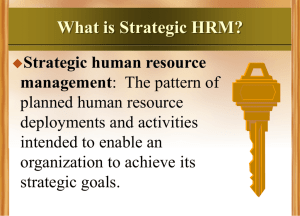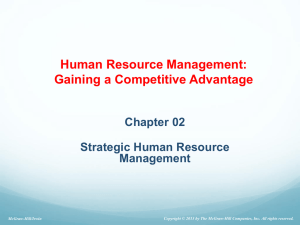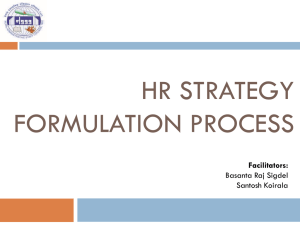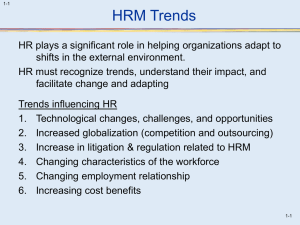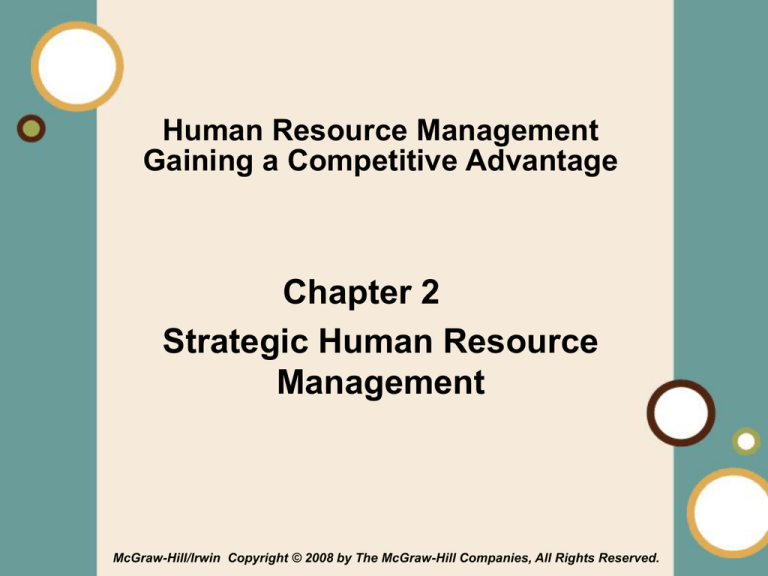
Human Resource Management
Gaining a Competitive Advantage
Chapter 2
Strategic Human Resource
Management
McGraw-Hill/Irwin Copyright © 2008 by The McGraw-Hill Companies, All Rights Reserved.
1-1
Learning Objectives
After reading this chapter, you should be able to:
• Describe the differences between strategy formulation
and strategy implementation.
• List the components of the strategic management
process.
• Discuss the role of the HRM function in strategy
formulation.
• Describe the linkages between HRM and strategy
formulation.
• Discuss the more popular typologies of generic strategies
and the various HRM practices associated with each.
• Describe the different HR issues and practices associated
with various directional strategies.
2-2
Introduction
• Goal of strategic management – To
deploy and allocate resources in a way
that gives organization a competitive
advantage.
• HRM function must be integrally involved
in the company’s strategic management
process.
2-3
What is Strategic Management?
• Strategic Management is a
process, an approach to addressing
the competitive challenges an
organization faces.
• Strategic human resource
management is the pattern of
planned human resource
deployments and activities intended
to enable an organization to achieve
its goals.
2-4
Components of the Strategic
Management Process
• Strategy Formulation
• Strategy Implementation
2-5
Model of the Strategic
Management Process
Forecasts of Strategy Formulation
Labor Demand
External
Analysis
Strategy Implementation
HR Practices
Opportunities
Threats
Mission
Goals
Strategic
Choice
Internal
Analysis
Strengths
Weaknesses
Human
Resource
Needs
Skills
Behavior
Culture
Recruiting,
Training,
Performance management,
Labor relations,
Employee relations,
Job analysis
Job design,
Selection,
Development,
Pay structure,
Incentives,
Benefits
Human
Resource
Capability
Skills,
Abilities,
Knowledge
Firm
Performance
Productivity,
Quality,
Profitability
Human
Resource
Actions
Behaviors,
Results
2-6
The Role of HRM in
Strategy Formulation
2-7
Strategy Formulation
External
analysis
Opportunities
Threats
Mission
Strategic
Choice
Goals
Internal
analysis
Strengths
Weaknesses
2-8
Strategy Formulation
• Five components of the strategic management
process:
– A mission is a statement of the organization's
reasons for being.
– Goals are what the organization hopes to
achieve in the medium-to long-term future
– External analysis consists of examining the
organization's operating environment to identify
strategic opportunities and threats.
– Internal analysis attempts to identify the
organization's strengths and weaknesses.
– Strategic choice is the organization's strategy,
which describes the ways the organization will
attempt to fulfill its mission and achieve its long
term goals.
2-9
Strategy Implementation
Organizational
structure
Types of
Information
Task Design
Product
market
strategy
Performance
Reward
systems
Selection,
training, and
development
of people
2-10
HRM Practices
• Job Analysis - the process of
• Job design - making decisions
getting detailed information about
about what tasks should be
jobs.
grouped into a particular job.
• Recruitment - the process
• Selection - identifying the
through which the organization
applicants with the appropriate
seeks applicants.
knowledge, skills, and ability.
• Training - a planned effort to
• Development - the acquisition of
facilitate learning of job-related
knowledge, skills, and behavior
knowledge, skills, and behavior.
that improves employees' ability
to meet the challenges of future
jobs.
•
•
•
Performance management - helps ensure that employees’ activities
and outcomes are congruent with the organization’s objectives.
Pay structure, incentives, and benefits.
Labor and employee relations.
2-11
Strategic Types
• Porter's Generic Strategies
– overall cost leadership, or
– differentiation.
2-12
HRM Needs in Strategic Types
• Different strategies require different
types of employees.
• Role Behaviors:
– Cost strategy firms seek efficiency and
therefore carefully define the skills they need
in employees and use worker participation to
seek cost-saving ideas.
– Differentiation firms need creative risk takers.
2-13
Directional Strategies
External Growth
Strategy
Concentration
Strategy
Internal Growth
Strategy
Downsizing
Mergers and
Acquisitions
2-14
The Role of HR in Providing
a Competitive Advantage
• Emergent Strategies - Those that
evolve from the grass roots of the
organization.
• Enhancing Firm Competitiveness
2-15

